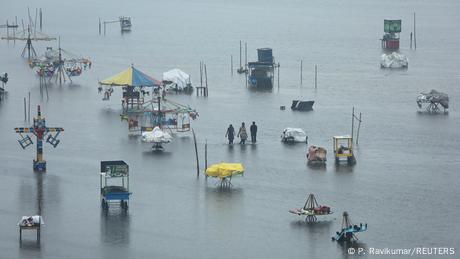India battles floods amid spike in extreme weather events

After dozens lost their lives in severe flooding in southern India, climate experts are now calling on government officials to prioritize climate-proof infrastructure and take measures to prevent further destruction from major weather events.
India’s tech hub Bengaluru was inundated by floodwaters, following torrential downpours which killed scores of people across the south of the country over the past few weeks.
Lakes surrounding the city, which is the capital of the southwestern Karnataka state, overflowed after three days of ferocious downpours, submerging roads, flooding homes, and leaving over 24 dead across the region.
Meanwhile, neighboring Andhra Pradesh state is continuing to reel from the aftermath of heavy rains and flash floods that wreaked havoc on the state, killing over 34 people. As a result, over 50,000 people have been lodged in relief camps in the four worst-affected districts.
Additionally, hundreds of vehicles and passengers were stranded after the main rail and driving routes were shut down.
In Tamil Nadu state, heavy rains shut down the capital Chennai earlier this month. The Indian Meteorological Department (IMD) later forecasted heavy to very heavy rainfall over the coming days in the region.
Monsoon rains ‘in excess’
“Clearly, the northeast monsoon rains are in excess this time. Yes, these are extreme weather events but I do not know whether this will become the new normal in the coming years,” IMD Director-General Mrutyunjay Mohapatra told DW.
Many scientists believe that instances of such extreme rainfall events will only become more frequent over the next years. Some are additionally calling on officials to prioritize the climate-proofing of infrastructure, in the face of these events.
In August this year, as monsoon floods raged across the subcontinent, the Intergovernmental Panel on Climate Change (IPCC) published its sixth assessment report, which noted the increasing frequency of heavy precipitation events since the 1950s and inferred that they were being driven by human-induced climate change.
A new study released by the Council on Energy, Environment and Water (CEEW) in October, ahead of the COP26 summit in Glasgow, maps India’s climate vulnerability. The study showed that the southern regions are the most vulnerable to extreme climate events and their compounding impacts.
Additionally, according to the CEEW, more than 80% of India’s population live in districts highly vulnerable to extreme disasters, including drought, floods and cyclones.
What’s more, only 63% of the country’s 748 districts have an official disaster management plan, and only a third of those which do have plans have updated them beyond 2019, the study found.
‘A surge in extreme events’
Given that India is the seventh-most vulnerable country with respect to climate extremes, climate action needs to be scaled up both at the sub-national and district levels, according to Germanwatch, a Bonn-based NGO.
“India needs to do a granular risk assessment which will account for hazards, risks and vulnerability. A surge in extreme events has been observed across India after 2005. Our sensitivity analysis shows that this is primarily triggered by landscape disruptions,” Abinash Mohanty, an author of the CEEW study, told DW.
“We also need to undertake climate-sensitive landscape restoration, focused on rehabilitating, restoring, and reintegrating natural ecosystems as part of the developmental process,” he added.
New irrigation to manage climate change
Other experts believe that mitigating floods and droughts would require connecting irrigation structures to capture rain and act as both a sponge for floods and a storehouse in drought.
“We are getting our water management wrong and building in floodplains, destroying our water bodies and filling up our water channels. We now see more rain and more extreme rain events,” Sunita Narain, the director-general of the Center for Science and Environment, told DW.
Narain believes that authorities need to plan systems properly in order to divert floodwater.
“It means linking rivers to ponds, lakes and ditches so that water is free to flow. This will distribute the water across the region and bring other benefits like refilling groundwater,” she said.
However, in most urban cities, waterways, which are seen as natural storm drains, have been overlooked in the name of land-centric urban growth.
After the devastating floods in Chennai in 2015, experts pointed out that the biggest culprit in the encroachment of urban waterways and wetlands was actually the state government, which had built runways, bus terminals and industrial parks by paving over bodies of water.
Moreover, in recent years, weather officials have pointed out that the surface water temperature of the Arabian Sea has risen from the normal of 27 degrees Celsius (80 degrees Fahrenheit) to up to 29 degrees, which is causing the frequent formation of low-pressure areas and cyclonic circulations, resulting in heavy rains.
Edited by: Leah Carter
SOURCE: DW News
Latest Thailand News
Follow The Thaiger on Google News:
































